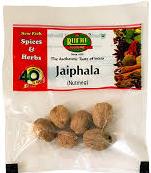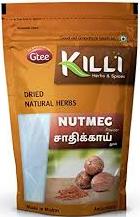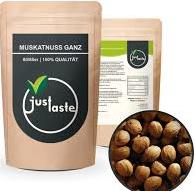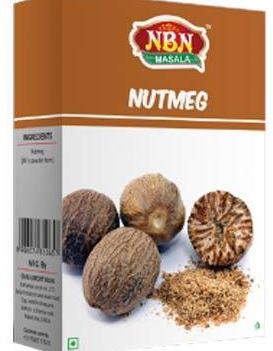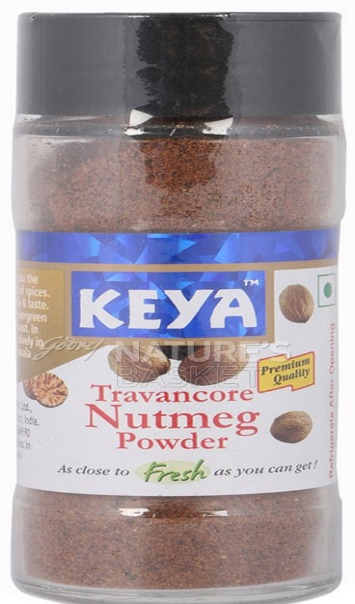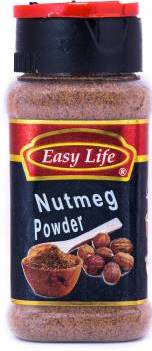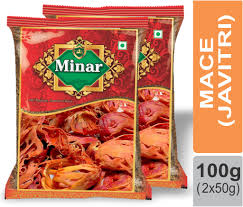A Tale of Two Spices: Nutmeg and Mace
Where does mace & nutmeg come from?
nutmeg and mace are actually a siblings. These two are obtained from the same fruit of the nutmeg tree called Myristica frangrans. The nutmeg is actually a fruit with a single seed(which makes it a drupe) is the oval-shaped pit, whereas mace is the surrounding lacy ‘aril’ which looks like a bright red webbing that surrounds the shell of the pit. The mace is removed, dried and then ground into a coarse powder that turns a reddish color. The nutmeg can either be dried and left whole and packaged for grating, or dried and grated fresh. The flavour of mace is similar to that of nutmeg, but is more refined. Mace is much more expensive than nutmeg. Inferior quality mace has very little aroma and is brittle. Both spices are used for flavouring savoury and sweet foods and as a medicine.
Nutmeg and mace are the two major primary products of Myristica fragrans plant and are commercially considered as spices.
The Nutmeg tree is native to the Banda Islands but also heavily cultivated in the Caribbean area including on the islands of Grenada and Jamaica. The fruits of the nutmeg tree have a hard pit in the middle that is the nutmeg. On the surfaces of those seeds is a covering that looks like melted wax and that is sometimes called an aril. That covering is mace.


Pic source-omex & pinterest
About Nutmeg Tree: –
Nutmeg trees are evergreens tree which is native to the Moluccas (Spice Islands) and other tropical islands of the East Indies or in Caribbean countries. The major nutmeg growing areas are Indonesia and Granada. It also grows on a smaller scale in Sri Lanka, India, China, Malaysia, Zanzibar, Mauritius and Solomon Island.
The large seed of these trees garners two noteworthy spices: nutmeg is the kernel of the seed when ground, while mace is the grated red to orange covering, or aril, which surrounds the seed.
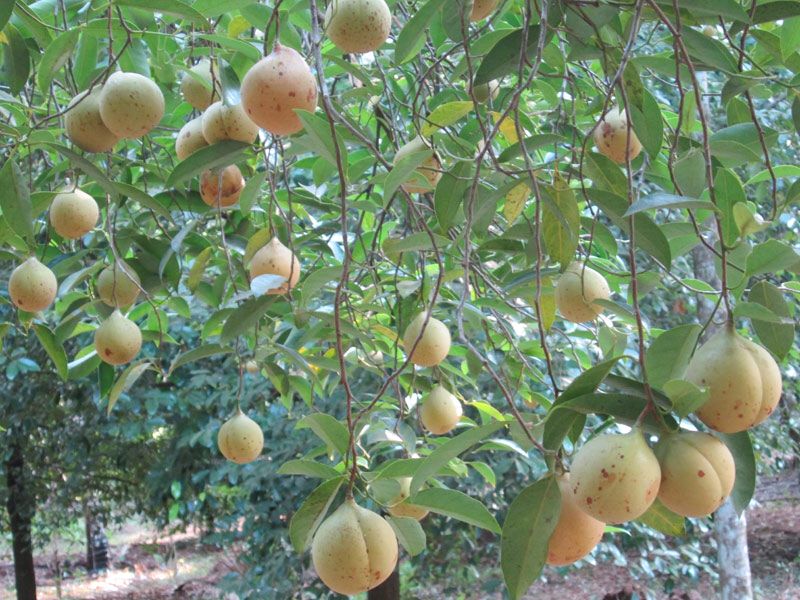
Pic source-pinterest
Seeds are collected from regular bearing and high yielding trees and having 30 g weight/fruit, 1 g wet mace /fruit and 10 g wet weight of nuts / fruit. Seeds are harvested during June – July. Fruit is a fleshy drupe, spherical in shape, pale yellow in colour with a longitudinal groove in the centre. When the fruit mature it burst open along the groove exposing the bright attractive mace, covering the hard black, shiny shell of the seed called nutmeg.
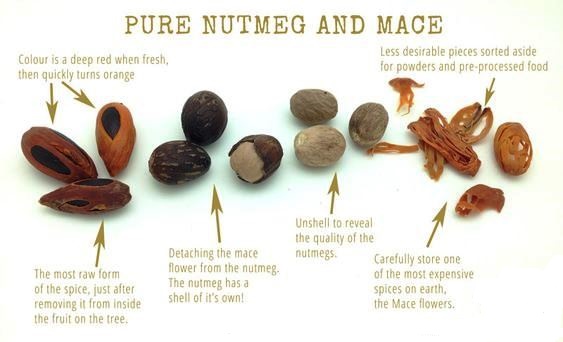
Common Name of Nutmeg in India:-
It is known as Jaiphal in Hindi, Urdu, Bengali, Marathi Punjabi & Gujrati,
- Jayikai in Kanada,
- Zaaphal in Kashmiri,
- Jathikka in Malayalam,
- Jaiphala in Oriya,
- Jatiphala in Sanskrit,
- Jathikai in Tamil,
- Jajikai in Telgu etc.
Common Name of Nutmeg in foreign countries: –
- Greek : Moschokarido
- Indonesia : Pala
- Italian : Noce moscata
- Spanish : Moscada
- Arabic : Jouza at-Teeb
- Chinese : Dou kou shu
- Dutch : Nootmuskaat
- French : Muscade
- German : Muskatnu
Nutmeg cultivation in India & in World:-
Nutmeg was introduced to Europe by Arab traders before the turn of 17th century. Nutmeg was the prime importance during the era of a spice trade and colonialism in the 16th century. Mollucan nutmeg trade first came under the control of Portuguese, who had to latter relinquish it to the Dutch. When the west indies region came under the British rule in the 19th century, Nutmeg tree were planted in Trinidad and Grenada.

Pic soure-agricare.kishanhelp.in
Nutmeg thrives well in warm, humid, conditions in locations with an annual rainfall of 150 cm and more. It grows well up to 1300 m above mean sea level. Clay loam, sandy loam and red laterite soils are ideal for its cultivation. Dry climate and water logged conditions are not good for nutmeg cultivation. There are two types of mace and nutmeg, West Indian (from Grenada) and East Indian (from Indonesia).
Over 50% of the worlds export of nutmeg and mace is from Indonesia. Grenada is the second largest exporter of nutmeg and mace in the world.
Nutmeg Cultivation in India: –
It was introduced in India at the end of the 18th century and mainly cultivated in certain pockets of Kerala, Tamil Nadu, and Karnataka states. Nutmeg is mainly cultivated in Thrissur, Ernakulam and Kottayam districts of Kerala and parts of Kanyakumari and Tirunelveli districts in Tamil Nadu. Andaman and Nicobar Islands has also got the best tropical and sub-tropical climate with good rainfall which is much suited for nutmeg cultivation.
How the Mace & Nutmeg are processed from the fruit: –
The fruits are opened by hand and the scarlet aril (mace) surrounding the nut is removed. Care needs to be taken to avoid damage to the nut. There is another method to take out the nuts from the fruit is to soak the nuts in water for four to twelve hours and then squeezed between the thumb and forefinger until the nut pops out. The separated mace is flattened by hand and dried on mats in the sun. This takes between two and four hours.


Pic source- season with spice
Grenadian mace is cured by storage in the dark for four months. This produces a brittle, pale yellow mace that attracts a premium price and is graded according to size, the bigger the mace, the better the premium. After grading the mace can be classified and bagged.
Whereas nutmegs are sun dried in their shells and regularly turned each day for proper drying and to prevent fermentation. It takes about minimum one week to complete drying in the good sunlight. Sometimes artificial dryers are also used in case of rainy season or winter season. To produce shelled nutmegs, they should be cracked by tapping the end of the nuts with a small wooden mallet.
Mace
Mace is the thin lacy material covering the kernel and represents only a small fraction of the weight of the kernel. For each 100kg of nutmeg, there is only 3-3.5kg of mace. The quality of mace depends on the amount of volatile oil. Mace is available in the market as whole, broken or ground types.
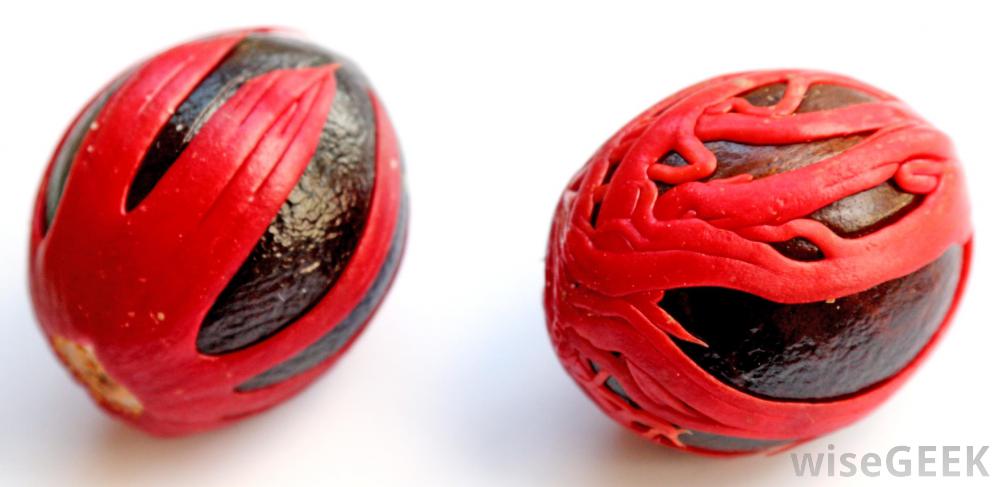

Pic source-wisegeek
Commercial mace consists of flattened lobed pieces, 2.5cm long and about 1mm thick. It has a similar taste and aroma to nutmeg, but is more delicate.
There are four different types of mace:
- Banda mace – considered to be the finest. It has a bright orange colour and fine aroma
- Java Estate mace – this mace is golden yellow interspersed with bright red streaks
- Siauw mace – this mace has a lighter colour than Banda mace and less volatile oil
- Papua mace – contains very little volatile oil (the oil that it contains has a pungent aroma).
Nutmeg:-
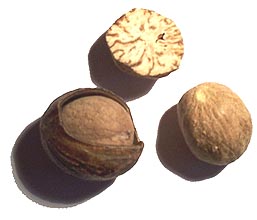
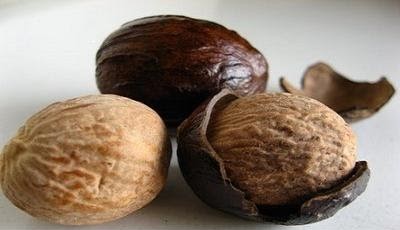
Pic source-Indiamart.
The nutmeg seeds are dried gradually in the sunlight over a period of six to eight weeks. During this time, the moisture in the ripe nutmeg berries evaporates resulting the nutmeg shrinks away from its hard seed coat. When completely dried in the sunlight we can see easily that the kernel will loosen from their outer shell and then it is separated from the outer coating or outer shell to obtain the Nutmeg and then it is further dried in the sun to achieve maximum 10-12% moisture content. Nutmegs are graded according to their size. Good quality of nutmeg counts approx. 200-215 pieces of nutmeg per kg. Nutmegs are usually sold whole, either with or without the shell.
Nutmeg can yield 7 to 16% of oil whereas mace can yield between 4 to 15% of oil approximately. This oil is used for flavouring food products and liquors and also in perfumery industries. Oleoresin of nutmeg and mace is used almost entirely in the flavouring of processed foods.
Culinary uses of nutmeg
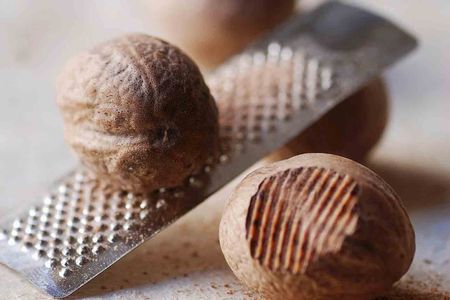
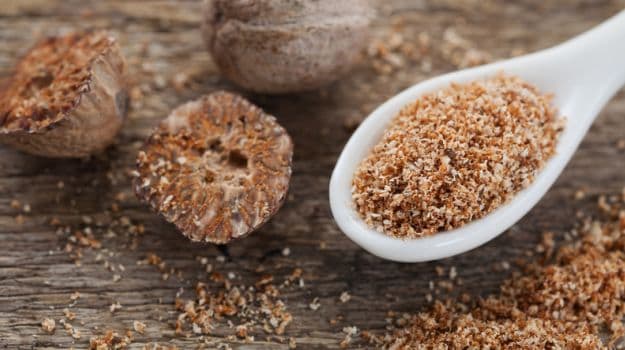
Pic soure-thespruceeat & NDTVFOOD
- Nutmeg has a long culinary history and can be part of both sweet and savory dishes. It can be used whole and grated directly into a recipe or measured or shaken from a canister of pre-ground nutmeg.
- In Indian cuisine, nutmeg is used almost exclusively in sweets such as kheer, phirni, cheesecake, puranpoli etc. A hint of nutmeg can also be perk up the taste of savoury dishes. Nutmeg is treasured for its flavor, aroma, and medicinal properties.
- Nutmeg should be used in small quantity in the preparation of food, Garam masala powder, Chai ka masala, & various regional Indian spices mixture etc.
- Nutmeg can also be grinded into fine powder and used for the marinades, stew,soup,sauces and used to sprinkle on several savoury dishes.
- Nutmeg is used in savory dishes, such as butternut squash soup, and pairs well with cream- or cheese-based recipes like a vegetable gratin.
- In other European cuisine, nutmeg and mace are used especially in potato dishes and in processed meat products; they are also used in soups, sauces and baked goods. Japanese varieties of curry powder include nutmeg as an ingredient. Nutmeg is a traditional ingredient in mulled cider, mulled wine, and eggnog.
- Nutmeg is usually associated with sweet, spicy dishes — pies, puddings, custards, cookies and spice cakes. It combines well with many cheeses, and is included in soufflés and cheese sauces.
- Nutmeg is a great partner for bananas – add a light grating to a banana cake mixture or sprinkle it on halved banana, top with brown sugar and fry in butter. Serve with whipped cream cheese on top and wait to hear your teeth chatter with delight.
- Nutmeg is also an ingredient in different spice blends, such as pumpkin pie spice, ras el hanout, and garam masala. It is also sprinkled over a variety of hot beverages like cappuccino and eggnog for added flavor and garnish.In the United States, one of the most common uses for nutmeg is in desserts, especially apple or pumpkin pie.
- Nutmeg is particularly well suited for creamy or cheesy dishes and is often added to alfredo or bechamel sauce to create depth.
- In soups it works with tomatoes, slit pea, chicken or black beans. It complements egg dishes and vegetables like cabbage, spinach, broccoli, beans onions and eggplant. It flavours Italian mortadella sausages, Scottish haggis and Middle Eastern lamb dishes. It is often included as part of the Moroccan spice blend ras el hanout. It is indispensable to eggnog and numerous mulled wines and punches.
Culinary use of Mace:-
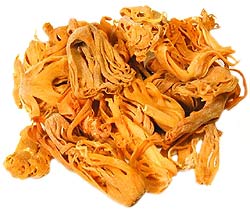

Pic souce-indiamart
- The flavour of Mace can be described as a combination of cinnamon and pepper flavour and it is more pungent version of nutmeg. is a common ingredient in Indian cuisine.
- The color of the Mace vary from origin to origin such as orange-red color of mace comes from Indonesia whereas orange-yellow color mace mostly belong to Grenada (Island of Indonesia), where mace is the national symbol.
- Indian mace is yellowish-red tinge color and is very aromatic in falvour. The flavor is similar to that of nutmeg but more peppery. It is available both in grounded and whole form. Whole dried mace is preferred over the grounded form for the preserved flavour.
- A small amount will enchance many recipes, adding fragrance without imposing too much flavour. Mace is slightly stronger and sweeter than nutmeg, and works particularly well in custard-based desserts. It especially complements dishes with cherries or chocolate.
- Some beverages improve with a little mace, especially chocolate drinks and tropical punches. Mashed potato and other root vegetables can be given an exotic kick by adding nutmeg or mace and spinach in particular is often seasoned with nutmeg, especially in Italian cooking. With regards to savoury meat dishes meat, nutmeg is often used as a substitute for black pepper, when a stronger and richer flavour is desired. You can add ground mace to meat marinades, sausage mixtures, curries and stews and nutmeg goes particularly well with lamb, chicken and veal.
- Mace works especially well with milk dishes like custards and cream sauces. It contributes to flavouring light-coloured cakes and pastries, especially donuts. It can enhance clear and creamed soups and casseroles, chicken pies and sauces. Adding some to mashed potatoes or sweet potatoes creates a more interesting side dish.
- It is the added as the main flavoring ingredient while preparing white sauce, lasagna, sausages, stews, jams and pastries. It gives the dominant flavour for doughnuts.
- In Indian cuisine, it is added both in sweet and savory dishes. Garam masala, an Indian spice mix contains nominal amounts of mace.
Curry powder in Japanese cuisine includes mace as an essential ingredient. - Due to its unique and versatile sweet flavour, it easily incorporate well with cheese dishes, sauce & soups, Souffles, Meat, poultry & Fish dishes etc.
- Mace can be used whole as a spices or in grounded form for flavour several dishes such as sweets, pulao, biryani and many savoury dishes.
- Mace powder is also used in preparation of several cakes & pies, donuts, Danish pastry etc. Mace pairs particularly well with tart berries and honey-sweet stone fruit.
- Mace also adds creative complexity to meaty braises and stews.
- It is highly recommended to buy the mace whole, not in powdered form as the essential oil contains in the spices have a tendency to loose its aroma after grinding it.
Precaution of using mace as a spices in cooking:-
The flavor can become bitter if it’s cooked too long, so it’s best to add mace toward the end of cooking as a finishing spice. Whole mace blades should also be removed before serving.
Health benefit of Nutmeg:-
- Nutmeg contains many essential volatile oils such as myristicin, elemicin, eugenol and safrole. volatile oils have anti-inflammatory properties that make it useful for treating joint and muscle pain.” Just a few drops of the essential oil on the affected area can treat inflammation, swelling, joint pain, muscle pain and sores.
- Nutmeg has a calming effect when consumed in smaller doses. Various ancient medicinal practices credit it for its sleep inducing and de-stressing effects. According to Ayurveda, you should add a pinch of nutmeg to a glass of warm milk and have it before sleeping. You can also add in some almonds and a pinch of cardamom for added benefits.
- Nutmeg contains essential oils which have a carminative effect on our system. So if you are suffering from digestive issues such as diarrhoea, constipation, bloating or gas, a home remedy is to grate a pinch of nutmeg in your soups and stews, and have it. It will help in the secretion of digestive enzymes, bringing about relief, whereas the fiber content in nutmeg will help in bowel movement. It also helps in removing excessive gas from the system.
- Nutmeg is an aphrodisiac, stimulating the nerves in the brain. It was commonly used as a brain tonic by the Greek and Romans during the ancient times. It is known to be an effective ingredient for treating depression and anxiety as its essential oil tend to ease fatigue and stress. “As an adaptogen, it can be both a stimulant and a sedative, according to the body’s needs. In times of stress, it can help lower blood pressure.
- Nutmeg is touted to help in detoxifying the body, clearing out toxins from the liver and kidneys. Since its essential oils have anti-bacterial properties, it helps in removing bacteria from the mouth which are responsible for causing bad breath. It is commonly used as an ingredient for Ayurvedic toothpastes and gum pastes. The essential oil eugenol helps in reliving toothaches as well.
- Nutmeg is a good ingredient for skincare because of its anti-microbial and anti-inflammatory properties as well as its ability to remove blackheads, treat acne and clogged pores. A common home remedy is to mix equal parts of ground nutmeg and honey, make a paste and apply it on pimples.
- Its high mineral content makes nutmeg a good ingredient for regulating blood circulation and pressure. It contains calcium, iron, potassium, manganese, etc., which are all essential for various functions in the body.
Heath Benefits of Mace
Nutmeg and mace are very similar in culinary and medicinal properties. Both spices are efficient in treating digestive and stomach problems. Below are some of the benefits obtained from small quantities of nutmeg spice or nutmeg oil.
- Mace aids digestion and also stimulates the appetite.
- It can help relieve tiredness and fatigue and is a good tonic.
- It can help clear up digestive tract infections.
- When applied externally, nutmeg oil can ease rheumatic pains and clear up eczema.
- It can relive intestinal gas and flatulence.
- It can reduce vomiting, nausea and general stomach uneasiness.
Processed Products of Nutmeg
- Nutmeg Powder or Ground Nutmeg
Dried nutmeg seeds are used for grinding in order to prepare fine powder of nutmeg. - Nutmeg Pickles
Fleshy pericarp of nutmeg fruits are used for making pickles, jams and jellies. - Nutmeg Oil
Nutmeg oil is extracted from nutmeg powder and it is rich in borneol and eugenol. Nutmeg essential oil is obtained by steam distillation of ground nutmeg. - Uses of Nutmeg Oil
Nutmeg oil is extensively used in perfumeries and pharmaceutical industries. Nutmeg oil is an essential ingredient in the manufacturing of tooth paste, cough syrups, and many traditional medicinal preparations. Nutmeg essential oil is used as a substitute for ground nutmeg or nutmeg powder in various food preparations as a flavoring agent.
